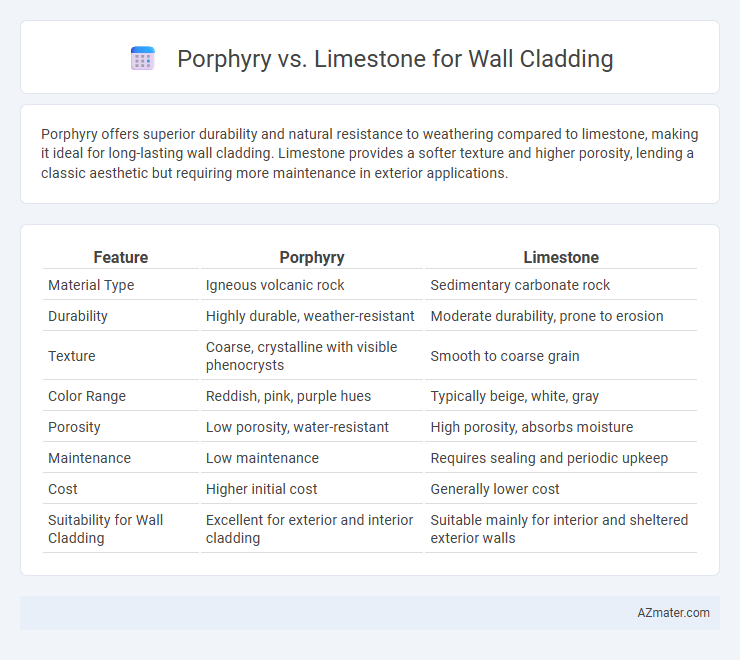Porphyry offers superior durability and natural resistance to weathering compared to limestone, making it ideal for long-lasting wall cladding. Limestone provides a softer texture and higher porosity, lending a classic aesthetic but requiring more maintenance in exterior applications.
Table of Comparison
| Feature | Porphyry | Limestone |
|---|---|---|
| Material Type | Igneous volcanic rock | Sedimentary carbonate rock |
| Durability | Highly durable, weather-resistant | Moderate durability, prone to erosion |
| Texture | Coarse, crystalline with visible phenocrysts | Smooth to coarse grain |
| Color Range | Reddish, pink, purple hues | Typically beige, white, gray |
| Porosity | Low porosity, water-resistant | High porosity, absorbs moisture |
| Maintenance | Low maintenance | Requires sealing and periodic upkeep |
| Cost | Higher initial cost | Generally lower cost |
| Suitability for Wall Cladding | Excellent for exterior and interior cladding | Suitable mainly for interior and sheltered exterior walls |
Introduction to Wall Cladding Materials
Porphyry and limestone are popular choices for wall cladding materials, each offering distinct aesthetic and functional benefits. Porphyry, a durable igneous rock with a unique speckled appearance, provides excellent weather resistance and low maintenance, making it ideal for exterior facades. Limestone, a sedimentary rock with a smooth texture and warm tones, is favored for its versatility and ease of carving, commonly used in both historical and modern architectural designs.
Understanding Porphyry: Composition and Characteristics
Porphyry is an igneous rock characterized by large, well-formed crystals, typically feldspar or quartz, embedded in a fine-grained matrix, which provides unique textural contrast and aesthetic appeal for wall cladding. Its high durability, natural resistance to weathering, and low porosity make porphyry a superior choice for exterior surfaces, especially in environments prone to moisture and temperature fluctuations. Porphyry's rich color variations, ranging from deep reds and purples to earthy browns, contribute to its popularity in architectural applications seeking both elegance and long-lasting performance.
Limestone Overview: Key Properties and Uses
Limestone is a sedimentary rock composed primarily of calcium carbonate, known for its durability, moderate porosity, and natural beauty, making it a popular choice for wall cladding. Its neutral tones and fine grain allow for versatile design applications in both interior and exterior facades while providing good resistance to weathering and environmental wear. The stone's moderate hardness and ease of cutting contribute to its widespread use in architectural elements, complemented by its ability to retain thermal mass and improve building insulation.
Aesthetic Differences: Porphyry vs Limestone
Porphyry offers a striking, volcanic appearance with deep red, purple, or brown hues and distinctive mineral crystals that create a textured, dynamic surface for wall cladding. Limestone provides a softer, more uniform aesthetic with subtle beige, cream, or gray tones and a smooth, matte finish, lending a natural and elegant look. Porphyry's rugged and bold visual impact contrasts with limestone's refined and understated charm, making each stone suitable for different architectural styles and design preferences.
Durability and Maintenance Comparison
Porphyry offers superior durability for wall cladding, resisting weathering and erosion due to its dense, igneous composition, making it ideal for long-term exterior applications. Limestone, while aesthetically versatile and easier to machine, is more porous and susceptible to acid rain and weathering, requiring regular sealing and maintenance to preserve its appearance. Maintenance for porphyry is minimal, typically involving only occasional cleaning, whereas limestone demands more frequent upkeep to prevent staining and surface degradation.
Environmental Impact and Sustainability
Porphyry wall cladding offers a low environmental impact due to its natural durability and minimal processing requirements, reducing energy consumption and waste during production. Limestone, while widely used, often involves higher quarrying and processing emissions, impacting ecosystems and contributing to a larger carbon footprint. Porphyry's longevity and resistance to weathering enhance sustainability by decreasing the need for frequent replacements compared to more porous limestone materials.
Installation Process: Porphyry vs Limestone
Porphyry wall cladding requires precise handling due to its dense, hard texture, often necessitating specialized cutting tools and anchoring systems to ensure secure installation on vertical surfaces. Limestone, being softer and more porous, allows for easier cutting and shaping, enabling faster installation with adhesives or traditional mechanical fixings, though it demands careful waterproofing to prevent moisture damage. Both materials require skilled labor, but porphyry installations typically involve more complex preparation and higher labor costs due to its durability and weight.
Cost Comparison and Budget Considerations
Porphyry wall cladding typically entails higher upfront costs due to its durability, unique texture, and limited availability compared to limestone, which is more abundant and generally affordable. Budget considerations should account for installation complexity and maintenance expenses, as porphyry's hardness demands specialized labor, increasing overall project costs. Limestone offers cost advantages for large-scale projects but may incur higher long-term maintenance due to its susceptibility to erosion and weathering.
Best Applications for Porphyry and Limestone Cladding
Porphyry offers exceptional durability and resistance to abrasion, making it ideal for high-traffic exterior wall cladding in commercial and urban environments where longevity and low maintenance are critical. Limestone provides a softer, natural aesthetic suitable for interior wall cladding, heritage restoration projects, and residential applications where elegance and a warm, textured finish enhance architectural beauty. Porphyry's dense composition supports use in harsh weather conditions, while limestone's versatile range of colors and textures works well in controlled environments with moderate exposure.
Choosing the Right Material for Your Project
Porphyry offers exceptional durability and a distinctive reddish hue ideal for high-traffic areas, while limestone provides a softer, more elegant appearance with excellent workability for intricate designs. Porphyry's natural resistance to weathering and abrasion ensures long-term performance on exterior walls, whereas limestone requires proper sealing and maintenance to prevent staining and erosion. Selecting the right material depends on project requirements such as aesthetic preference, durability needs, and environmental exposure.

Infographic: Porphyry vs Limestone for Wall Cladding
 azmater.com
azmater.com